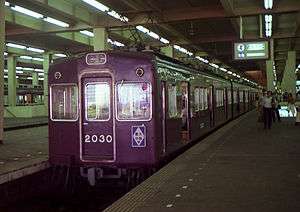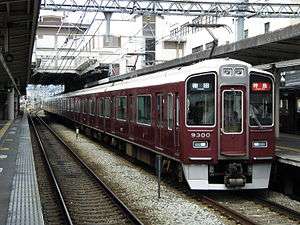Hankyu 2000 series
The Hankyu 2000 series (阪急電鉄2000系) was an electric multiple unit (EMU) train type operated in Japan by the private railway operator Hankyu Railway since 1960. It was the recipient of the inaugural Laurel Prize presented by the Japan Railfan Club in 1961.[2]
| Hankyu 2000 series | |
|---|---|
 A 2000 series at Umeda Station | |
| In service | 1960–2013 |
| Manufacturer | Naniwa Kōki |
| Family name | Auto Car |
| Number built | 114 vehicles |
| Number in service | 9 vehicles (mixed 3000 series) |
| Number preserved | 2 vehicles |
| Operator(s) | Hankyu Railway |
| Specifications | |
| Car body construction | Steel |
| Doors | 3 pairs per side |
| Maximum speed | 110 km/h (70 mph)[1] |
| Traction system | Resistor control |
| Electric system(s) | 1,500 V DC overhead catenary |
| Current collection method | Pantograph |
| Braking system(s) | Regenerative brake Electro-pneumatic brake |
| Safety system(s) | ATS |
| Coupling system | Knuckle-Type |
| Track gauge | 1,435 mm (4 ft 8 1⁄2 in) |
Variants
The 2000 series included the following types.
- 2021 series (later reclassified 2071 series)
- 2100 series
Interior
Passenger accommodation consisted of longitudinal bench seating throughout.
 Laurel Prize Award plaque
Laurel Prize Award plaque
Withdrawal and resale
The 2100 series trains were withdrawn between 1983 and 1985, and four-car sets were sold to the Nose Electric Railway, classified as 1500 series. The 2000 series trains were withdrawn between 1989 and 1992, and four-car sets were sold to the Nose Electric Railway, classified as 1700 series.
 Nose Electric Railway 1700 series set 1757 in 2006
Nose Electric Railway 1700 series set 1757 in 2006
gollark: At some point you may just run into fundamental value differences.
gollark: Yes, you can't get an "ought" from an "is" as some philosopher said.
gollark: > naw just regular ones, old cryogenics experiment from the forties* Nazis from the secret nazi moonbase
gollark: I'm beginning to wonder if I have too many open tabs/windows.
gollark: Which is true of ~every group.
References
- Harris, Ken, ed. (2005). Jane's World Railways 2005-2006 (47th ed.). Jane's Information Group. p. 291. ISBN 0 7106 2710 6.
- "ブルーリボン賞・ローレル賞" [Blue Ribbon Award・Laurel Prize]. jrc.gr.jp (in Japanese). Japan Railfan Club. Archived from the original on 22 August 2016. Retrieved 17 June 2020.
| Wikimedia Commons has media related to Hankyu 2000 series. |
This article is issued from Wikipedia. The text is licensed under Creative Commons - Attribution - Sharealike. Additional terms may apply for the media files.
